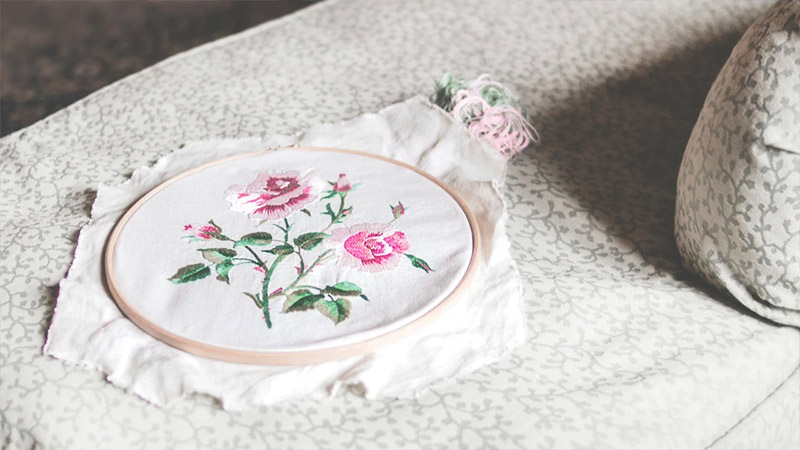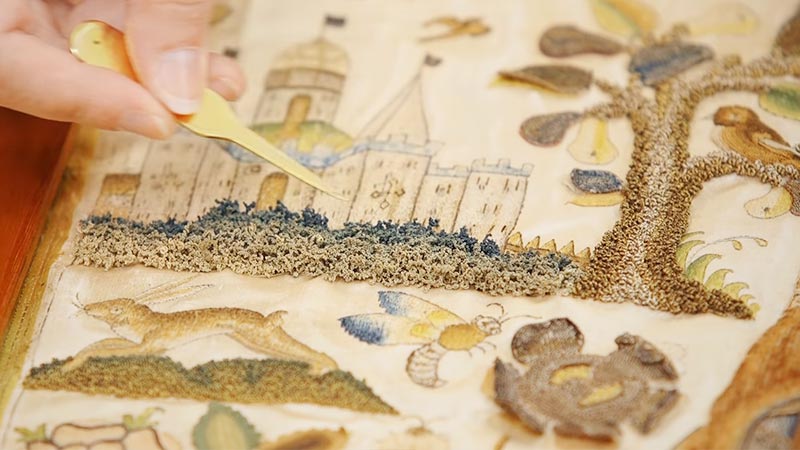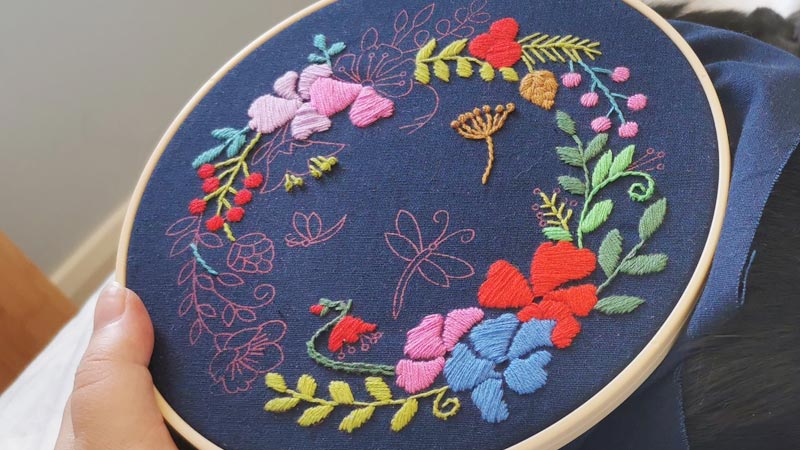Embroidery, a timeless art form, weaves a rich tapestry of human creativity across the ages. The origins of embroidery are as diverse as the intricate stitches and patterns it encompasses.
From the ancient silk threads of China’s Han dynasty to the vibrant storytelling threads of indigenous Central American cultures, embroidery’s birthplace remains elusive, symbolizing its universal appeal.
India’s Chikankari, Persian motifs of the Middle East, European Renaissance elegance, and Africa’s vibrant beadwork all contribute to the global mosaic of this craft.
This exploration delves into the unique regional histories that have shaped embroidery, celebrating its remarkable journey from cultural tradition to artistic expression.

What Is Embroidery?
Embroidery is a time-honored textile art form that involves embellishing fabric with intricate and decorative designs using needle and thread.
It is a painstaking craft that transforms plain fabrics into works of art. The essence of embroidery lies in the meticulous handwork, which can range from simple stitches to complex and ornate patterns.
Embroidery employs a variety of stitching techniques, including the basic running stitch, satin stitch, cross-stitch, and countless others, each offering a unique texture and aesthetic.
Embroiderers often use a wide range of materials, such as silk, cotton, wool, or metallic threads, and sometimes incorporate beads, sequins, or other embellishments to enhance the visual impact.
Beyond its decorative applications on clothing, household items, and accessories, embroidery serves as a means of storytelling and cultural expression.
Many cultures have distinct embroidery traditions that reflect their history, beliefs, and values. In contemporary times, embroidery has evolved into an art form that blends tradition with innovation, fostering creativity and self-expression.
Where Is the Origin of Embroidery?

Embroidery is an ancient and intricate craft that has been practiced by various cultures around the world for thousands of years.
Pinpointing a single origin for embroidery is a challenging task, as it developed independently in multiple regions, each contributing to its rich and diverse history.
The exact birthplace of embroidery is elusive, but we can explore its beginnings in various parts of the world.
Let’s explore where did embroidery originate:
China
Chinese embroidery stands out for its meticulous craftsmanship and rich history. During the Han dynasty, it played a significant role in the embellishment of clothing and textiles.
Intricate silk embroidery, using techniques such as Suzhou embroidery and Shu embroidery, became highly sought after.
These traditions involved the use of fine silk threads, delicate stitches, and designs often inspired by nature, mythology, and cultural symbolism.
India
India’s embroidery traditions are a testament to its cultural diversity. Kantha embroidery, originating in West Bengal, involves quilting layers of old saris and creating beautiful patterns with running stitches.
Chikankari, from Lucknow, is famous for its delicate white-on-white embroidery. Phulkari from Punjab is characterized by vibrant floral motifs. These techniques not only adorn textiles but also tell stories of India’s history and heritage.
Middle East
Persian embroidery, with its use of intricate patterns and vivid colors, has made a lasting impact. The use of fine threads and detailed stitches characterizes Persian embroidery, and it has been employed in various aspects of daily life, from clothing to interior decor.
Additionally, Islamic calligraphy and geometric designs often find expression through embroidery in the Middle East.
Europe
In Europe, embroidery has a long history intertwined with both fashion and art. During the Middle Ages, it was used to adorn ecclesiastical vestments, and in the Renaissance, it decorated lavish garments.
Techniques like English crewelwork, with its intricate and colorful woolen designs, and Hungarian embroidery, known for its folkloric motifs, reflect regional diversity and craftsmanship.
Central and South America
Pre-Columbian civilizations in Central and South America have a rich tradition of embroidery. The Mayans, for example, used vibrant threads to depict stories and myths on their clothing and textiles.
In Peru, the art of “manta” involves intricately embroidered fabrics with symbolic representations of their culture and history.
Africa
African embroidery showcases the continent’s rich cultural diversity. The Maasai beadwork from East Africa involves the meticulous stitching of colorful beads into elaborate patterns, often used in jewelry and garments.
Various African communities employ embroidery to communicate stories, traditions, and symbols, each with its unique flair and style.
History of Embroidery Timeline

The history of embroidery is a rich tapestry that spans thousands of years, encompassing diverse cultures, techniques, and styles.
To better understand this intricate art form, let’s explore a timeline that highlights key milestones in the history of embroidery:
Prehistoric Era (30,000 BCE – 5,000 BCE)
- 30,000 BCE: Archaeological findings suggest that the earliest known embroidery work occurred in regions that would later become Russia and China. These early embroiderers used simple materials like animal sinew and bone needles to create basic decorative designs on clothing and other textiles. These artifacts reveal a nascent form of artistic expression through embroidery.
- 5,000 BCE: As prehistoric cultures in the Middle East and South Asia advanced, they continued to develop their embroidery techniques. Simple geometric patterns and motifs adorned clothing and textiles, reflecting the creativity and cultural identity of these ancient peoples.
Ancient Civilizations (3,000 BCE – 500 CE)
- 3,000 BCE: Embroidery was documented in ancient Egypt, where it was primarily used to decorate clothing, household items, and religious garments. The Egyptians employed a variety of materials, such as linen, wool, and even precious metals like gold and silver thread, to create intricate designs.
- 2,000 BCE: The Indus Valley Civilization, located in what is now India and Pakistan, demonstrated a rich tradition of embroidery. Intricate patterns were discovered on pottery and textiles, emphasizing the importance of this art form in daily life and religious rituals.
- 500 BCE: Embroidery found its way into ancient Greece, Rome, and Persia, where it played a pivotal role in enhancing the beauty of garments, banners, and religious textiles. These early civilizations adapted and expanded upon embroidery techniques and designs, influencing the subsequent evolution of the craft.
The Silk Road Era (1st Century BCE – 14th Century CE)
- 1st Century BCE: Chinese embroidery techniques, characterized by the use of silk threads and intricate stitches, became highly sought-after commodities along the Silk Road. These techniques showcased the advanced artistry of the Chinese people and influenced neighboring regions.
- 6th – 7th Century CE: The Byzantine Empire and Islamic cultures significantly contributed to the development of complex and ornate embroidery styles. Elaborate patterns and motifs inspired by the interplay of geometry and nature characterized these embroidery traditions.
- 14th Century CE: The Italian city of Florence became a renowned center for Renaissance embroidery. Florence was celebrated for its exquisite craftsmanship, with artisans producing embroidery that was both artistic and functional. This era saw a fusion of various embroidery traditions, resulting in a style that was uniquely European.
Medieval and Renaissance Europe (5th Century – 17th Century)
- 5th Century: Ecclesiastical embroidery became prominent in European churches, with ornate garments, altar cloths, and other religious textiles receiving intricate embroidery. These creations reflected the importance of faith and reverence in the medieval world.
- 14th Century: This period marked the establishment of embroidery guilds and schools across Europe. These organizations not only refined embroidery techniques but also provided a platform for artisans to promote artistic expression through needlework.
- 17th Century: The famous “Opus Anglicanum” (English Work) emerged in England. It was characterized by its extraordinary intricacy and use of gold and silver threads. Opus Anglicanum pieces were highly sought after and prized by European royalty and the Church.
FAQs
Was embroidery always considered an art form, or was it initially a practical craft?
Embroidery began as a practical craft, often used to reinforce and decorate clothing and textiles.
Over time, it evolved into an art form, appreciated for its aesthetic and cultural significance.
What role did religion play in the development of embroidery in various cultures?
Religion has often played a significant role in the development of embroidery, with many religious texts and ceremonies featuring intricately embroidered garments and textiles, such as vestments and Torah covers.
Did embroidery techniques and designs travel between different regions and cultures throughout history?
Yes, embroidery techniques and designs often traveled with trade and cultural exchange, influencing and merging with local traditions.
How has technology impacted the practice of embroidery in the modern age?
Technology has introduced machine embroidery, making it faster and more accessible.
Wrap Up
Embroidery’s elusive origin reflects its remarkable journey as a universal craft. From the intricate silks of ancient China to the vibrant threads of Central America and the rich motifs of Persia, embroidery’s diverse regional histories have interwoven with human culture for millennia.
This art form evolved from practical necessity to artistic expression and storytelling, revealing the collective creativity of our global heritage.
As contemporary artisans continue to push the boundaries of tradition and innovation, embroidery remains a bridge connecting the threads of our shared history.
Its enduring appeal and adaptability across time and cultures attest to the enduring beauty of this craft, perpetuating a legacy of human artistry and creativity.
Leave a Reply